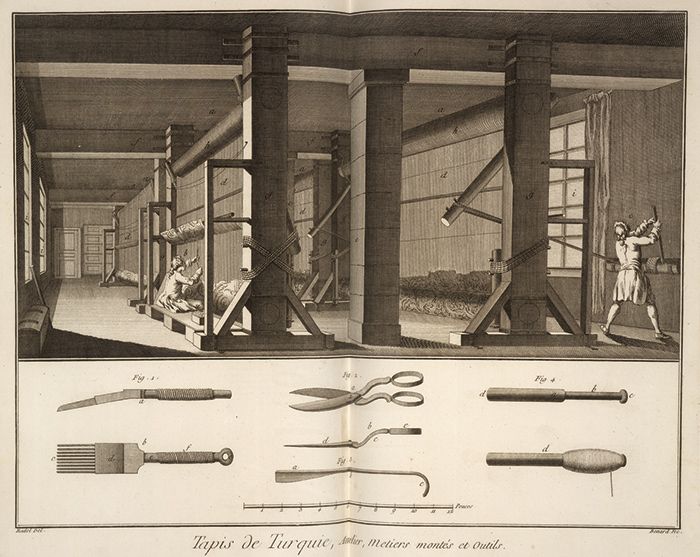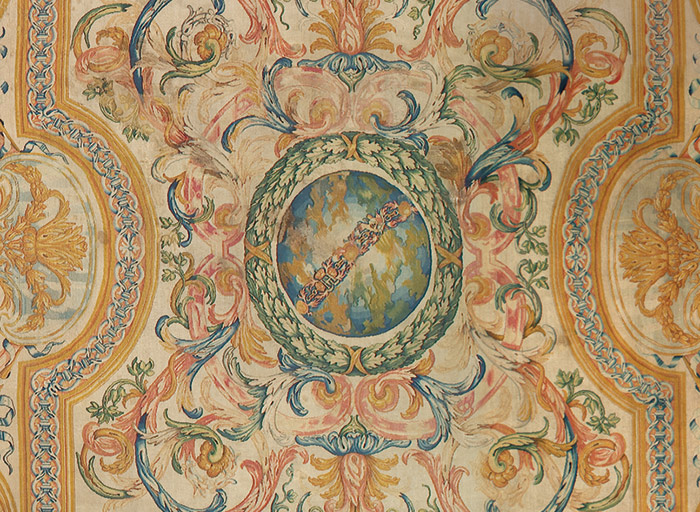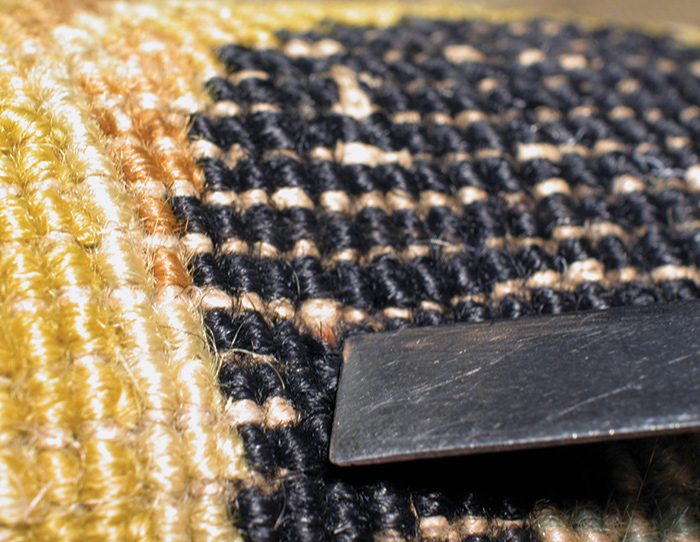The Huntington’s blog takes you behind the scenes for a scholarly view of the collections.
The Missing Fleurs-de-lis
Posted on Fri., July 10, 2015 by

The carpet Astrology , as it is currently displayed in The Huntington Art Gallery. This carpet and its companion, Music , have been been exhibited on the floor of the Large Library since the Huntington mansion first opened as a museum in 1928. Photo by Kate Lain.
Next Tuesday is Bastille Day, when France celebrates the start of the French Revolution, which began with the storming of the Bastille on July 14, 1789. To mark the occasion, we highlight items in The Huntington’s European art collection that have been forever altered due to the revolution’s success.
Located in the Large Library of the Huntington Art Gallery, two carpets—Astrology and Music—are among 93 large carpets commissioned around 1665 by King Louis XIV to line the Grand Gallery of the Louvre, his Parisian palace. In 17th-century France, the world seemingly revolved around the Sun King, as Louis XIV was known, who was famous for his absolute rule as well as the lavishness of his court and lifestyle.
For 24 years, the Savonnerie Manufactory was dedicated to the task of producing carpets for the Louvre that, laid next to each other, would have extended 1,460 feet. By 1689, all but one of the carpets had been completed, but by then, the king had moved his court to the countryside in Versailles, abandoning his interior design plans for the Louvre.

Two men working at a carpet loom, from Denis Diderot, Encyclopédie, ou, Dictionnaire raisonné des sciences, des arts et des métiers, vol. 31 (Paris: 1751–80). The Huntington Library, Art Collections, and Botanical Gardens.
“The carpets were stored in the national furniture warehouse in Paris,” says Catherine Hess, chief curator of European art at The Huntington. “They were never displayed together, as originally intended, but they were still greatly prized. When 10 were presented as diplomatic gifts, replacements were immediately woven to replace them.”
Astrology, in particular, has revolutionary ties. It is believed to have been on the floor of the meeting room of the 1789 Estates-General in Versailles. This meeting of representatives from the nobility, clergy, and common people was called in an attempt to solve a French financial crisis. After an impasse of several months, the Third Estate (the common people) declared themselves the National Assembly, or representatives of the people. Their declaration led to the French Revolution. Thus Astrology was walked upon by the first revolutionaries to protest against the absolute rule of King Louis XVI, the great-great-great-grandson of the Sun King.
The focal point of Astrology is a terrestrial globe, centered among lavish designs, scrollwork, and a wreath of oak leaves. The chain of office of the Order of the Holy Spirit—the highest order of French chivalry—encircles the globe. This symbol emphasized the Sun King’s position in the world order: his monarchy located at the center of France; France, at the center of Europe; and Europe, at the center of the world.

Detail from Astrology, showing the chain of office of the Order of the Holy Spirit encircling the globe. The royal fleurs-de-lis on the ribbon were replaced with a garland of oranges after the French Revolution. The Huntington Library, Art Collections, and Botanical Gardens.
While Louis XIV’s absolutism was unmatched in his day, the monarchy’s strength waned after his death, finally falling under the reign of Louis XVI. And when the monarchy fell, its symbols had to be removed.
After Louis XVI’s execution and the public sale of the royal furniture, the fleurs-de-lis that originally decorated the ribbon of the Order of the Holy Spirit on Astrology were replaced with a garland of oranges. This alteration removed all vestiges of the monarchy and feudalism from the carpet, which came to reside in the new government’s Ministry of Justice. Musicalso lost its fleurs-de-lis and royal monograms.
Arabella Huntington first saw the carpets in the London apartment of American financier J.P. Morgan in 1911. A lover of French decorative arts, Arabella was enamored of the carpets and purchased them after Morgan’s death in 1913. Although Morgan had large portions of the carpets cut out in order to make them fit around his fireplaces, these sections were repaired and rewoven before the carpets arrived at The Huntington.

The quality of the carpets is related to how densely they are knotted. Each square inch of Astrology (detail shown here) contains 90 to 130 knots.
Today, the new seams and alterations are still visible, if you look closely. They reflect the carpets’ history—a history woven into the very fibers of Astrology and Music.
You can read more about the Savonnerie carpets in Kimberley Chrisman-Campbell’s “In the Footsteps of the Sun King” on page 14 in the Spring/Summer 2006 issue of Huntington Frontiers.
Related content on Verso:
Open to Interpretation (March 17, 2015)
Olivia Hummer is an intern in the office of communications and marketing at The Huntington.